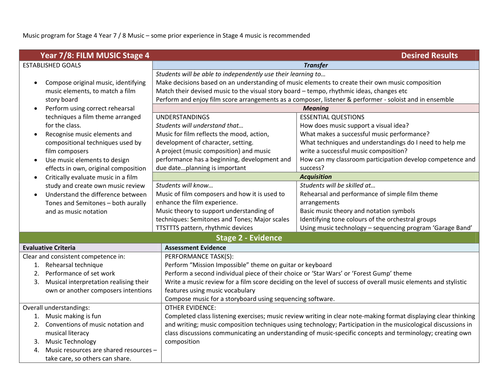
This Junior Music program outlines clear objectives in plain English. Meets requirements/outcomes for Listening, Composition and Performance. The assessment rubric links directly to the classroom activities and...the students will have fun learning to play easy to learn film themes as they develop their listening skills and vocabulary!
Students will:
- build on their aural skills by identifying and manipulating rhythm, pitch, dynamics and expression, form and structure, timbre and texture in their listening, composing and performing of music written for Film.
- aurally identify layers within a texture
- play independent parts against accompanying parts (melody, chordal and bass lines)
- recognise rhythmic, melodic and harmonic patterns and beat groupings
- understand their role within an ensemble choosing tone colours and gradations in volume
- perform with expression and some technical control
- identify a variety of purposes for which film music is made
- draw on music exploring a range of cultures, times and locations as they experience film music over its development.
The Composition unit may be used with Garage Band or other sequencing/notation software to develop:
- Inquiring – identifying, exploring and organising information and ideas in a music soundtrack
- Identify and clarify information and ideas in pairs as the work is developed
- Organise and process information to meet the task requirements
- Generating ideas, possibilities and actions based on a study of film music
- Imagine possibilities and connect ideas creating a sound track.
- Consider alternatives
- Reflecting on thinking and processes
- Think about thinking (metacognition)
- Reflect on processes
- Analysing, synthesising and evaluating reasoning and procedures
- Draw conclusions and design a course of action.
Simply follow the ten week (or, modify to suit) program!
Students will:
- build on their aural skills by identifying and manipulating rhythm, pitch, dynamics and expression, form and structure, timbre and texture in their listening, composing and performing of music written for Film.
- aurally identify layers within a texture
- play independent parts against accompanying parts (melody, chordal and bass lines)
- recognise rhythmic, melodic and harmonic patterns and beat groupings
- understand their role within an ensemble choosing tone colours and gradations in volume
- perform with expression and some technical control
- identify a variety of purposes for which film music is made
- draw on music exploring a range of cultures, times and locations as they experience film music over its development.
The Composition unit may be used with Garage Band or other sequencing/notation software to develop:
- Inquiring – identifying, exploring and organising information and ideas in a music soundtrack
- Identify and clarify information and ideas in pairs as the work is developed
- Organise and process information to meet the task requirements
- Generating ideas, possibilities and actions based on a study of film music
- Imagine possibilities and connect ideas creating a sound track.
- Consider alternatives
- Reflecting on thinking and processes
- Think about thinking (metacognition)
- Reflect on processes
- Analysing, synthesising and evaluating reasoning and procedures
- Draw conclusions and design a course of action.
Simply follow the ten week (or, modify to suit) program!
Something went wrong, please try again later.
This resource hasn't been reviewed yet
To ensure quality for our reviews, only customers who have purchased this resource can review it
Report this resourceto let us know if it violates our terms and conditions.
Our customer service team will review your report and will be in touch.
$5.00
